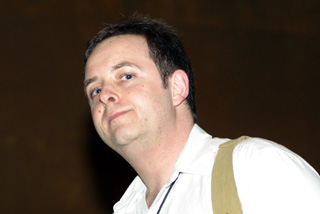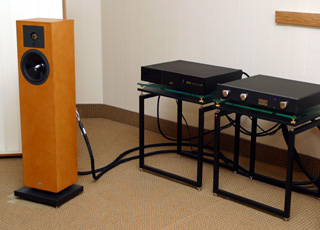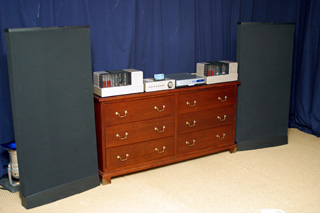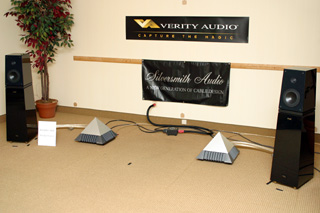 |
||||
| May 15, 2005 Searching for the Extreme: Le Festival Son & Image 2005
Immediately after my elevator ride to the ninth floor of the Delta Hotel -- the main site of the Festival Son & Image in Montreal, Canada -- and my subsequent arrival at the first exhibit, I discovered that I’d forgotten to bring a pen. Feeling naked, I repaired to my room to get one, only to discover that I’d failed to pack this important commodity. Nor, I noticed with increasing panic, could I find a pen anywhere in the room, which was strange. Isn’t there always some form of writing instrument in a hotel room? I had no choice but to eat a large slice of crow pie and attempt to scrounge some sort of writing implement. On my return to the top floor (you take an elevator to the top floor of the Festival and work your way down via the stairs), I sidled up to Mike Vince of StudioLab and quietly explained my predicament. He was incredulous. "You don’t have a pen?" I hung my head in shame and mumbled in the negative. After a brief pause he handed me one from a box of promotional pens he had on hand. While there, I meekly sat down and had a listen to their Reference Revelation loudspeaker ($11,000 per pair; all prices in Canadian dollars unless otherwise noted), which I’d heard on several other occasions. This time, the StudioLab boys were playing some highly entertaining didgeridoo music that showed off to good effect the Revelation’s bass reach and weight. Other than some changes to the binding posts and finish, this speaker is essentially unchanged from last year. Mike Vince is a perfectionist, so this is a good sign; if what I heard was any indication, he’s right on the money. Don’t change a thing, Mike. Having gotten my journalist act together, I dropped into the Mission suite. They were doing a classic bait and switch, surreptitiously placing the new M-Cube 5.1 microsystem ($2000 USD including subwoofer) satellites right next to some full-size speakers in an attempt to make visitors think they were listening to the big boys. The M-Cubes did a pretty good job, too, sounding much larger than they had any right to. The M-Cube’s robust driver, an evolution of the NXT flat panel, doesn’t require a grille. Overall, the M-Cube sounded very good, and its suede-like accents looked very smart. Next, I stopped off in the Audiopathic room to say hi to Matt Brasseau, nonconformist extraordinaire. Matt was manning a tubes-and-vinyl-only room and looking rather smug about it. With good reason -- the Focal-JMlab Mini Utopia Be speakers sounded swell driven by the art deco VAC 110 amp ($19,000 USD) and 2.0 preamp ($17,000 USD). Motivation was provided by a boatload of high-end analog gear: an Avid Acutus turntable resplendent in chrome, joined by a Wheaton Triplanar tonearm and Phase Tech cartridge. Brasseau didn’t have the exact cost of this rig to hand, but he told me that it definitely exceeds $20,000 USD.
Midsize systems don’t get a lot of respect in audio, where bragging rights often go to the biggest and most expensive, so it was great to see a number of systems that didn’t break the bank while providing tons of musical involvement. One of these was in the Planar Audio room. Fronted by NEAT Acoustics’ Elite speaker ($4800 per pair) and powered by an LFD Zero Silver Signature integrated amp ($2000), this reasonably priced combo sounded rhythmic and juicy, but could get just a bit shouty near its upper limits. I found another example of extreme sound for reasonable cash in the Roksan room. Roksan's new speaker, the FR-5 ($4500 per pair), is an unassuming floorstander finished in gloss black. A two-way with dual woofers, the FR-5 reproduced a Marcus Miller bass solo with incredible aplomb, dishing out rhythmic waves of deep, tight bass in a highly seductive manner. These low-profile columns are designed to be placed close to a front wall, and would look simply smashing in your downtown loft. The rest of Roksan’s show system consisted of their Caspian M-series components, including the CD player ($2495), preamp ($2595), and monoblock amplifiers ($2395 each). "Free beer?" That’s what I thought the attractive young lady said to me as I passed the Celestion room. "I beg your pardon?" "Would you like a free beer?" This was obviously a cheap lure to try to get me into their room and scam some show coverage of their products, even though they didn’t fit the Ultra Audio profile. Inside, Celestion was showing their AVP-501 5.1 line-array speakers, which come complete with an 8", 100W powered subwoofer. The system looks to be a good value at $1999. Very refreshing!
But enough about midsize stuff that people can actually afford -- after all, this is Ultra Audio, right? What about the Enterprise-class stuff? Let’s work our way slowly upward beginning with Quad, that old English matriarch who 50 years ago started us all on the path to the true high end with the first commercially viable electrostatic speaker. Here in the Korbon Trading room was the Quad ESL-989 ($12,500 per pair), a direct descendant of the ESL-63 electrostatic, itself a refinement of the original Quad ESL-57 speaker. The rest of the system was of equally high pedigree: Quad II Forty tube amplifiers and Quad 22 preamp ($9000 the set), and a Quad 99 CD player ($2399). The ESL-989 didn’t seem to suffer from the limited dynamics and somewhat thin bass of its predecessor. However, that’s a bit of an understatement. These babies slammed bass, reproducing some cracking electric blues with authority. I must admit that playing this music through these speakers seemed rather undignified, sort of like watching your grandmother surfing the crowd at a Red Hot Chili Peppers concert. Moving rapidly upscale, I came in short order to the Fidelio Audio room. Not a manufacturer of audio equipment, Fidelio Audio is in the business of recording sparse, austere, emotion-filled music in the most pure and direct manner possible. While they’ve moved away from SACD and back to 16-bit CD, if the music I heard is any indication, their new XtractHD (computer-free CD) process seems to have made the loss of resolution a moot issue. Fidelio has long used Verity Audio speakers, and this time they’d moved up a notch, from the Parsifals to the Sarastros ($42,000 per pair). Reflecting their pro-audio leanings, Fidelio uses Nagra electronics exclusively, biamping the Sarastros with two pairs of VPA tube amplifiers ($25,000 per pair) and feeding them with a PLP preamp ($15,000) and DAC ($15,000). I had a chance to listen to a master tape, which they were playing on a Nagra T half-inch reel-to-reel ($45,000 plus modifications, no longer available), and while it did sound somewhat more transparent than 16-bit CD, the difference was much less dramatic than I’d anticipated. These are some seriously good-sounding CDs. The Fidelio room never fails to impress me, and is always a highlight of my weekend in Montreal. This combination of what has to be one of the best-sounding speakers in the world, statement-level tube amplification, and music that forcefully transports you to the original recording venue, is an experience you shouldn’t miss. KonnectSon had a rockin’ room this year. The Raidho Emilie S-Centric speaker ($4400 USD per pair) sounded fantastic driven by a boatload of Cary Audio Design gear. Headlining the display was the new CAD-500MB monoblock amplifiers ($3995 each). In supporting roles were their all-tube SLP-98L preamplifier ($3995) and CD-303/300 CD player ($5495), the latter featuring massive oversampling and an output stage switchable on the fly between solid-state and tube operation. Cabling in this low-key but high-end system was all Nordost Valhalla, with power-supply duties handled by Nordost’s Thor Power Distribution Block ($4500).
As reported in the SoundStage! A/V show coverage, Verity Audio has introduced a refined version of their bread-and-butter speaker, the Parsifal. The Parsifal Ovation ($24,500 per pair) is pretty much new from the ground up, and features a new tweeter. This is of the utmost significance to me -- the clear, silky, edge-free top end of the original Parsifal was one of the main reasons that any room featuring this speaker ended up near the top of my best-sound-of-show list. Fortunately, the Parsifal Ovation retains that Verity house sound in the top octaves, sounding just as smooth as its predecessor but adding even more image solidity, bass extension and impact, and just a teeny bit more top-end extension than I remember from previous auditions. What a relief! Show conditions can make for miserable listening experiences, a point driven home by the large size and central location of the room housing the VTL-Avalon system. Because there was plenty of room for people to move around and chat, I had little opportunity on Saturday to get the measure of this formidable system. The background noise in the room was akin to that found in a busy bar, and more often than not someone was standing right in front of one of the speakers. After a few minutes of this, VTL’s Luke Manley suggested that I come back on Sunday morning for a private audition, before the room officially opened. Considering that we had to raise our voices to be heard even when there was no music playing, this seemed prudent. Bright and early the next day, I got a chance to listen to a truly statement-level system while seated in a very comfy red leather chair. In tetrode mode (800W into 4 ohms), the VTL Siegfried monoblocks ($40,000 USD per pair), via the VTL TL7.5 preamp ($13,500 USD), gripped the Avalon Diamond speakers ($40,000 per pair) lovingly but firmly. This was a true U-R-there audio experience in which there was no point discussing midrange neutrality, bass weight, or treble smoothness. This system transcended such demarcations to simply reproduce the music right there in the room. Triode mode (with a measly 400W!) lost some of the focus but delivered some very comfortable warmth. Suddenly the Avalons were gripped firmly but lovingly. I could have sat there all day. I didn’t get a chance to sit down for a listen to Sonus Faber’s Stradivari Homage speakers ($54,000 per pair) until fairly late on Sunday, as the room was quite busy each time I stopped by. I’m very happy I persisted -- this system was in the running for the best sound of the show. In sharp contrast to many of the systems I listened to over the weekend, the Stradivari Homages driven by Ayre electronics -- V-5xe amplifier ($4500 USD), C-5xe universal player ($5950 USD), and K-5xe preamplifier ($2950 USD) -- had an honest musicality that was at odds with the size of the presentation. The sheer ease of this combination of American muscle and Italian grace forced me to sit down and take notice, even though I was supposed to have met my wife five minutes before. With a monstrous soundstage and a commensurate sense of power and scale, this system made for a superb ending to a great show. What fun! ...Jason Thorpe
Ultra Audio is part of the SoundStage! Network. |



